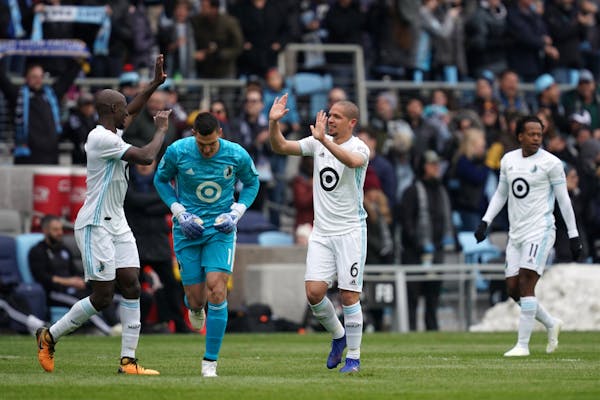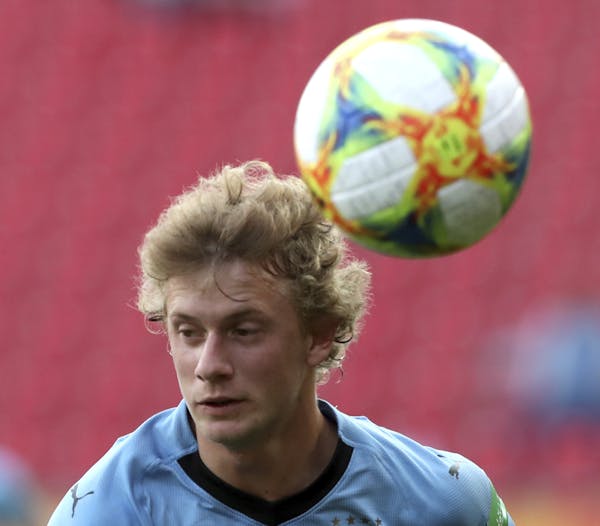Minnesota United ownership paid $100 million in 2015 for a MLS franchise and another $250 million for a sparkly new stadium that broke ground in 2017.
Two years later, it has turned its investments toward the pitch, including its most seismic deal yet.
Its forthcoming acquisition of teenage Uruguayan midfielder Thomas Chacon is a multi-year, multi-million dollar transaction that makes it a player in soccer's international transfer market and puts it in step with a MLS that, 24 years on now, isn't just where aging superstars go to retire anymore.
Still trailing Europe's best leagues in pace and payroll, MLS is becoming a viable destination for developing young stars from South America and elsewhere on their way to finding fortune in Europe.
Paraguayan midfielder Miguel Almiron played two seasons with Atlanta FC, helping it win its first MLS Cup last year, before Newcastle United in England's Premier League paid a $27 million transfer fee for him, a record for a MLS player.
Atlanta paid more than $29 million in transfer fees to acquire Argentinians Gonzalo Martinez and Ezequiel Barco. That's more than three times the $8.5 million transfer it paid in 2016 to acquire Almiron, whom Atlanta flipped for triple the price three years later. Countryman Brian Fernandez left a Mexican team for Portland in a $10 million transfer.
Now Chacon — a small (5-5) but uniquely gifted central playmaking midfielder who turns 19 this month — is United's most bold move yet. He will arrive late in a season when United has added from that international market starters Romain Metanire, Jan Gregus, Vito Mannone and Robin Lod as well as Wilfried Moimbe-Tahrat. All left leagues across Europe in differing stages of their career for a new team, new league and a new way of life.
From soccer's second divisions in France, Spain and England, the top division in Denmark and now Uruguay's top league, United management believes it has found a better class of player to help lift it to the MLS playoffs for the first time.
"This league is changing," United coach Adrian Heath said. "The league is growing. The talent is better. Look at the stadiums; our stadium is on par with any stadium in the world. The corporate hospitality, the facilities for players, all of it adds up to a very enticing project for these players."
Money entices talent
MLS' current $200 million expansion fee already is twice what United managing partner Bill McGuire and his group of founding Minnesota families paid only four years ago. At last week's All-Star Game in Orlando, MLS Commissioner Don Garber said new expansion teams headed to Sacramento and St. Louis will invest between $550 million and $650 million in stadiums, land and franchise fees before they become the league's 28th and 29th teams.
MLS remains a league where aging European stars such as Zlatan Ibrahimovic and Wayne Rooney still cash in near their career's end, just as David Beckham, Thierry Henry and others did before them.
If Ibrahimovic has lost a step at age 37, he still, at 6-5, stands in skill and scoring literally a head above.
Just ask him. He recently told ESPN he considers himself a "Ferrari among Fiats" in an American league the L.A. Galaxy star said could be "so much faster, more tactical, so much more rhythmic."
The money paid at the highest ends of MLS still pales to the rest of the world. Ibrahimovic's $7.2 million salary is MLS' biggest — but in Spain, FC Barcelona pays Lionel Messi $84 million annually.
American advantages
Reaching his prime at age 28, Gregus accepted United's $883,500 total compensation salary offer for one of its three top-end "designated player" slots to join a league and country about which he knew little.
He deems MLS different from his last two seasons with FC Copenhagen in Denmark's Superliga because of its air travel, United's superior training facilities and a consistently sold-out stadium so far.
"You can see there's huge quality in the league and it grows every year," Gregus said. "You can see it in all the fast, technical players. I didn't know what to expect, but now I'm here and I'm part of it. If you want to be successful, you need to adapt fast."
Gregus consulted Slovakia national teammate and Real Salt Lake's Albert Rusnak before he signed and other former teammates and peers now call him.
"A lot of players have told me they want to come here as well," Gregus said. "I tell them they can come here and still play in good quality. A lot of them would like to, but it's not that easy."
No retirement league
Almiron's transfer to Newcastle signaled something of a sea change, indicating he and other young international players can develop and increase their value while using MLS as a steppingstone to Europe.
Both Garber and United sporting director Manny Lagos call it the league's evolution to becoming part of the massive global soccer market.
"The league really needed to go from the promise of what soccer can be in the U.S. and Canada to actually delivering on that," Garber said earlier this season. "Miguel Almiron is a great example of that. This is a guy who five years ago would not have been playing in Major League Soccer, let alone being sold for a record amount to Newcastle. … We need to be engaged in the global market if we want to be one of the top league in the world."
On Sunday (and again on Wednesday), Minnesota United plays Portland and 24-year-old winger Fernandez, who left Mexico's top Liga MX for MLS.
Longtime Loons midfielder Miguel Ibarra said he was "kind of shocked" Fernandez moved to MLS and noted young Mexican star Uriel Antuna joined Galaxy on loan from Manchester City.
"There was a time when this was called a retirement league," Ibarra said. "Now you don't really hear that as much."
A league of destination
Now MLS is a league that has attracted both the 30-something superstar and the rising international player, while several young U.S. national team members have graduated or bypassed MLS to play in Europe. Last winter, England's Chelsea paid a $73 million transfer fee, the most ever for an American-born player, to acquire 20-year-old midfielder Christian Pulisic from Germany's Borussia Dortmund.
Lagos said "there's no doubt we are becoming a league of destination" and "a league of relevance" for rising young international players, those in their prime and aging stars alike.
"We are becoming a league that's part of this global business," he said.
Add the arrival of new distinguished international coaches, too: Atlanta's Frank De Boer, L.A. Galaxy's Guillermo Barros Schelotto, New York City FC's Domenec Torrent and San Jose's Matias Almeyda, among them.
"MLS is getting better, 100 percent," Torrent, the Spanish assistant to esteemed coach Pep Guardiola at Barcelona, said earlier this season. "The stadiums are amazing. The fans are amazing. The teams want to keep the ball and play really well. I'm very happy to be here. I expect MLS in the next one, two years will be maybe not the level in Europe right now, but a little bit similar.
"Every single team has four, five players able to play in Europe because they have quality. American players will improve if you play with the best players every season. This is good news for the American people, the American players."
Lod, a Finnish national team player who was set to make his Loons debut Sunday, joined from Spain's second division after United wooed him the past 18 months.
"The MLS and this club are improving really fast," Lod said. "The reputation is getting much better now."
French athletes at Paris Olympics will receive better mental health protection
Chinese Grand Prix could deliver drama to F1 and slow Verstappen's victory march
NFL draft will include many Michigan men, maybe enough to break record set by 2022 Georgia Bulldogs


